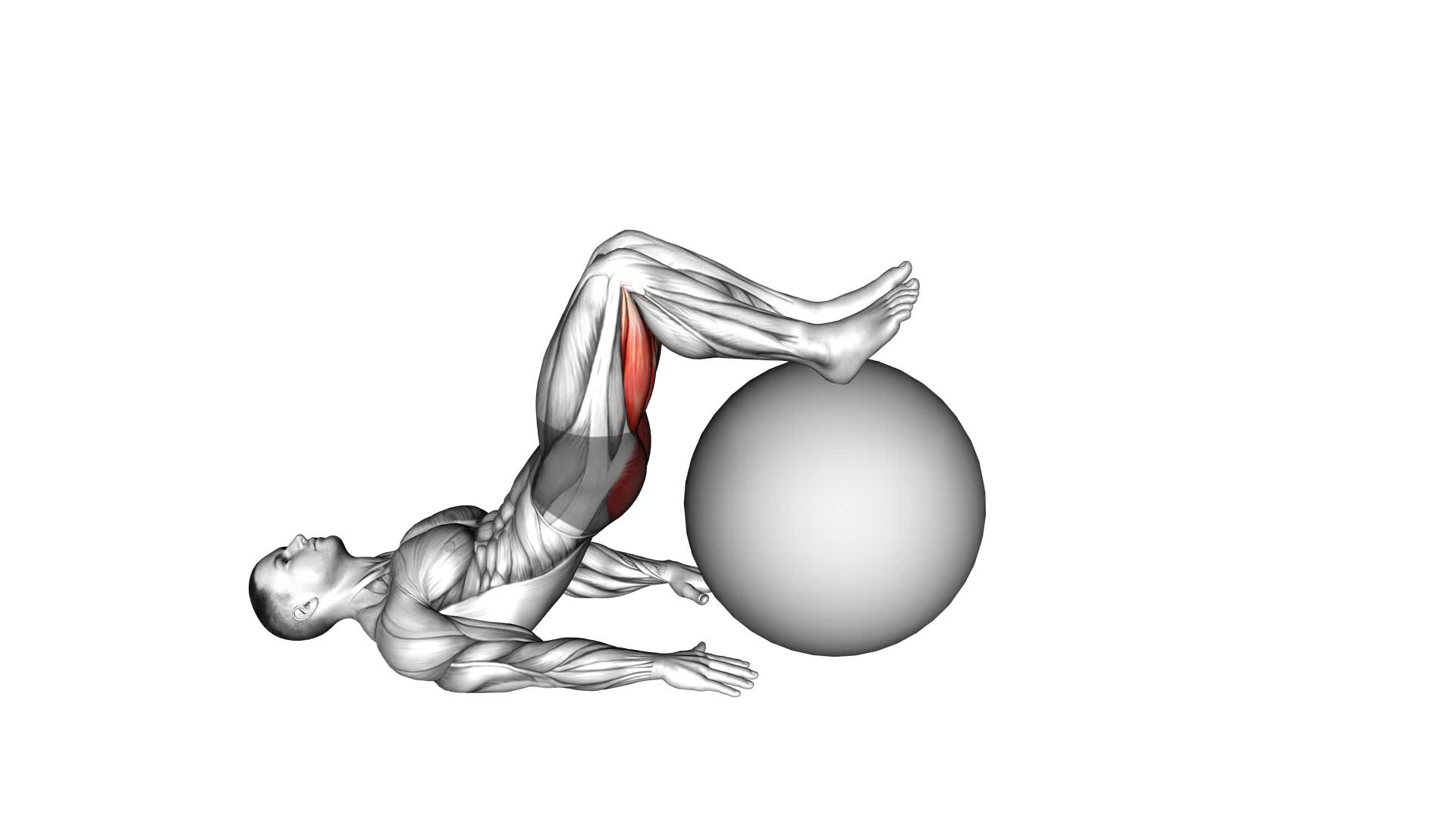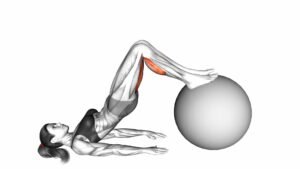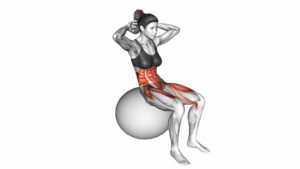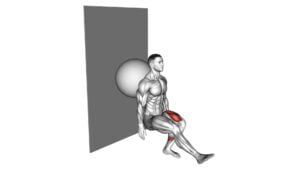Exercise Ball Leg Curl – Video Exercise Guide & Tips

Get ready to strengthen your legs with the exercise ball leg curl. This video exercise guide and tips will show you how to properly perform this effective exercise.
Watch This Exercise Video
By using an exercise ball, you will engage your hamstrings, glutes, and core muscles. Avoid common mistakes and maximize your results with the proper form and technique.
Whether you're a beginner or advanced, this exercise can be modified to suit your fitness level. Let's get started and take your leg workout to the next level.
Key Takeaways
- Exercise ball leg curls are highly effective for muscle activation and injury prevention.
- They engage and activate the hamstrings, glutes, and calves, strengthening the lower body muscles and improving function and stability.
- Exercise ball leg curls can enhance athletic performance and reduce the risk of injury.
- Incorporating variations and progressions can prevent plateaus and continue making progress in workouts.
Benefits of the Exercise Ball Leg Curl
You should regularly perform the exercise ball leg curl to reap its numerous benefits. This exercise is highly effective for muscle activation and injury prevention. When you perform the exercise ball leg curl, you engage and activate several muscles in your lower body, including your hamstrings, glutes, and calves. This helps to strengthen these muscles, improving their overall function and stability.
By strengthening these muscles, you can also enhance your athletic performance and reduce the risk of injury during activities that require lower body strength and power, such as running or jumping. Additionally, the exercise ball leg curl can help to improve your balance and stability, as you need to maintain proper form and control throughout the movement. This can be particularly beneficial for older adults or individuals recovering from injuries.
Proper Form and Technique
To ensure proper form and technique during the exercise ball leg curl, it's important to focus on maintaining a stable position and controlling the movement throughout.
Start by positioning yourself on the floor with your back on the ground and your legs straight, placing your heels on top of the exercise ball. Keep your arms relaxed by your sides, palms facing down.
Before starting the exercise, it's crucial to perform a proper warm-up, including stretching exercises for your hamstrings and glutes. This will help increase flexibility and reduce the risk of injury.
Once you're in the starting position, engage your core muscles to stabilize your body. Slowly bend your knees, rolling the exercise ball towards your buttocks. Continue the movement until your knees are fully flexed and your feet are firmly planted on the ball.
Pause for a moment and then reverse the movement, extending your knees and rolling the ball back to the starting position. Throughout the exercise, focus on maintaining control and avoid any jerky or abrupt movements.
To maximize the effectiveness of the exercise, it's essential to activate the correct muscles. Prioritize engaging your hamstrings and glutes throughout the movement. This can be achieved by consciously squeezing these muscles as you curl the exercise ball towards your buttocks.
Variations and Progressions
Explore different variations and progressions of the exercise ball leg curl to challenge your muscles and enhance your workout. Here are some advanced modifications and resistance band variations to try:
- Single Leg Curl: Instead of using both legs, perform the exercise with one leg at a time. This increases the demand on your hamstrings and glutes, making it more challenging.
- Stability Ball Rollouts: Start in a plank position with the exercise ball under your feet. Slowly roll the ball towards your body by bending your knees and curling the ball with your feet. This variation adds an element of core stability and requires more control.
- Eccentric Leg Curl: Focus on the eccentric, or lowering, phase of the exercise. Slowly extend your legs to the starting position, taking 3-4 seconds to do so. This emphasizes the lengthening of the hamstring muscles and increases muscle activation.
- Resistance Band Leg Curl: Attach a resistance band to a stable anchor and loop it around your ankles. While performing the exercise ball leg curl, the resistance from the band adds extra tension to the movement, further challenging your muscles.
Incorporating these variations and progressions into your exercise routine can help you continue making progress and prevent plateaus. Remember to always prioritize proper form and technique to maximize the benefits of the exercise.
Common Mistakes to Avoid
When performing the exercise ball leg curl, it's important to be aware of common mistakes to avoid. These mistakes can't only hinder your progress but also increase the risk of injury.
One common mistake is using momentum to lift your hips instead of engaging your hamstring muscles. This takes away the focus from the targeted muscle group and reduces the effectiveness of the exercise.
Another common mistake is lifting your hips too high, which can put unnecessary strain on your lower back. It's important to maintain a straight line from your shoulders to your knees throughout the movement.
Additionally, avoid allowing your feet to roll outwards or inwards during the exercise. This can lead to imbalances and strain on the knee joint.
Maintaining proper form and technique is crucial in order to get the most out of the exercise ball leg curl and prevent injury. By avoiding these common mistakes, you can ensure that you're targeting the right muscles and maximizing the benefits of this exercise.
Now let's move on to some tips for maximizing results.
Tips for Maximizing Results
To maximize your results with the exercise ball leg curl, it's crucial to focus on proper form. This means maintaining a straight line from your head to your heels, engaging your core, and avoiding any swinging or arching of the back.
Additionally, prioritize rest and recovery to allow your muscles to repair and grow stronger.
Proper Form Importance
To maximize your results, focus on maintaining proper form during the exercise ball leg curl. Proper form is crucial for injury prevention and maximizing muscle activation. Here are four important tips to help you achieve proper form:
- Position yourself correctly: Lie on your back with your arms by your sides and your feet on the exercise ball. Ensure that your hips and lower back are in a stable position.
- Engage your core: Before starting the exercise, activate your core muscles by drawing your belly button towards your spine. This will help stabilize your body throughout the movement.
- Control the movement: Slowly bend your knees and roll the exercise ball towards your glutes, keeping your hips lifted. Avoid rapid or jerky movements to maintain control and prevent injury.
- Extend your legs with control: Once you have curled the ball towards your glutes, slowly extend your legs back to the starting position, maintaining control and tension in your hamstrings.
Rest and Recovery
To maximize your results, it's important to prioritize rest and recovery.
Many people underestimate the importance of sleep in their fitness journey. Sleep is crucial for muscle repair and growth, as well as overall recovery. Aim for 7-9 hours of quality sleep each night to allow your body to fully recharge.
In addition to sleep, incorporating active recovery strategies into your routine can also help maximize your results. Active recovery involves engaging in low-intensity exercises or activities on your rest days. This can include activities like stretching, yoga, or light walking.
Active recovery promotes blood flow, reduces muscle soreness, and helps prevent injuries.
Consistency Is Key
How can you maximize your results and achieve your fitness goals?
Consistency is key when it comes to seeing progress in your workouts. Here are some tips to help you stay consistent and overcome challenges:
- Set realistic goals: Start with small, achievable goals that you can work towards. This will help you stay motivated and track your progress.
- Create a schedule: Plan your workouts in advance and stick to a regular routine. Treat your workouts like appointments that you can't miss.
- Find accountability: Whether it's a workout buddy or a fitness group, having someone to hold you accountable can help you stay on track.
- Celebrate milestones: Recognize and celebrate your achievements along the way. This will help you maintain motivation and stay committed to your fitness journey.
Sample Workout Routine
Start your workout routine with a warm-up session to prepare your body for the exercise ball leg curl. This will help prevent injuries and improve your overall performance. Incorporating workout modifications and choosing the best exercises for beginners is essential to ensure a safe and effective workout.
To begin, try performing a set of bodyweight squats to activate your lower body muscles. This exercise will help you improve your leg strength and stability. Start by standing with your feet shoulder-width apart, then lower your hips down as if you're sitting back into a chair. Make sure to keep your knees aligned with your toes and your chest lifted throughout the movement. Aim for 10-15 repetitions.
Next, you can move on to the exercise ball leg curl. Lie on your back with your legs extended and your heels resting on top of the exercise ball. Engage your core and lift your hips off the ground, then bend your knees and roll the ball towards your glutes. Pause for a second, then slowly extend your legs back to the starting position. Repeat for 10-12 repetitions.
Finish your workout routine with a cool-down session, which can include stretching exercises and deep breathing to help your body recover and relax. Remember to listen to your body and adjust the intensity of the exercises as needed. Stay consistent with your workout routine, and you'll see progress over time.
Frequently Asked Questions
How Many Repetitions Should I Do for the Exercise Ball Leg Curl?
To determine the repetition range for the exercise ball leg curl, you need to consider your fitness level and goals. Beginners should start with 8-12 repetitions per set, while more experienced individuals can aim for 12-15 repetitions.
Remember to maintain proper form throughout the exercise.
Additionally, variations of the exercise, such as single-leg curls or adding resistance bands, can be incorporated to challenge your muscles and increase the intensity of your workout.
Can I Perform the Exercise Ball Leg Curl if I Have a Knee Injury?
If you have a knee injury, it's important to take precautions when performing the exercise ball leg curl.
While it can be a beneficial exercise for strengthening your hamstrings and glutes, it may put strain on your knees.
Consider injury modifications, such as using a lighter weight or reducing the range of motion.
Alternatively, you can explore alternative exercises that target the same muscle groups without putting excessive stress on your knees.
Always consult with a healthcare professional for personalized advice.
Is It Necessary to Warm up Before Doing the Exercise Ball Leg Curl?
Before performing the exercise ball leg curl, it's essential for you to warm up. Dynamic stretching before exercise helps to increase blood flow, improve flexibility, and prepare your muscles for the upcoming workout. It also reduces the risk of injury during the exercise.
After completing the leg curls, don't forget to cool down with some static stretches. Cooling down is important for gradually decreasing your heart rate and preventing muscle soreness.
How Often Should I Include the Exercise Ball Leg Curl in My Workout Routine?
To determine how often to include the exercise ball leg curl in your workout routine, consider your fitness goals and current level of strength. Gradually progress the exercise by increasing the number of sets or repetitions, or by adding resistance.
Including this exercise regularly can help improve your hamstring and glute strength, enhance stability, and boost overall lower body strength.
Consult with a fitness professional to ensure proper form and to tailor the exercise to your specific needs.
Can I Use a Stability Ball Instead of an Exercise Ball for the Leg Curl Exercise?
Yes, you can definitely use a stability ball instead of an exercise ball for the leg curl exercise. The stability ball is a great alternative equipment that offers numerous benefits.
It helps to engage your core muscles, improve balance and stability, and target your hamstrings effectively. By using a stability ball, you can add variety to your workout routine and challenge your muscles in a different way.
Conclusion
In conclusion, the exercise ball leg curl is a highly effective exercise for strengthening and toning the leg muscles. By using the exercise ball, you can target your hamstrings and glutes while also engaging your core for stability.
It's important to maintain proper form and technique to maximize the benefits and prevent injury. Additionally, incorporating variations and progressions into your routine can add challenge and keep your workouts interesting.
Remember to avoid common mistakes and follow the tips provided to achieve optimal results.

Author
Years ago, the spark of my life’s passion ignited in my mind the moment I stepped into the local gym for the first time. The inaugural bead of perspiration, the initial endeavor, the very first surge of endorphins, and a sense of pride that washed over me post-workout marked the beginning of my deep-seated interest in strength sports, fitness, and sports nutrition. This very curiosity blossomed rapidly into a profound fascination, propelling me to earn a Master’s degree in Physical Education from the Academy of Physical Education in Krakow, followed by a Sports Manager diploma from the Jagiellonian University. My journey of growth led me to gain more specialized qualifications, such as being a certified personal trainer with a focus on sports dietetics, a lifeguard, and an instructor for wellness and corrective gymnastics. Theoretical knowledge paired seamlessly with practical experience, reinforcing my belief that the transformation of individuals under my guidance was also a reflection of my personal growth. This belief holds true even today. Each day, I strive to push the boundaries and explore new realms. These realms gently elevate me to greater heights. The unique combination of passion for my field and the continuous quest for growth fuels my drive to break new ground.



